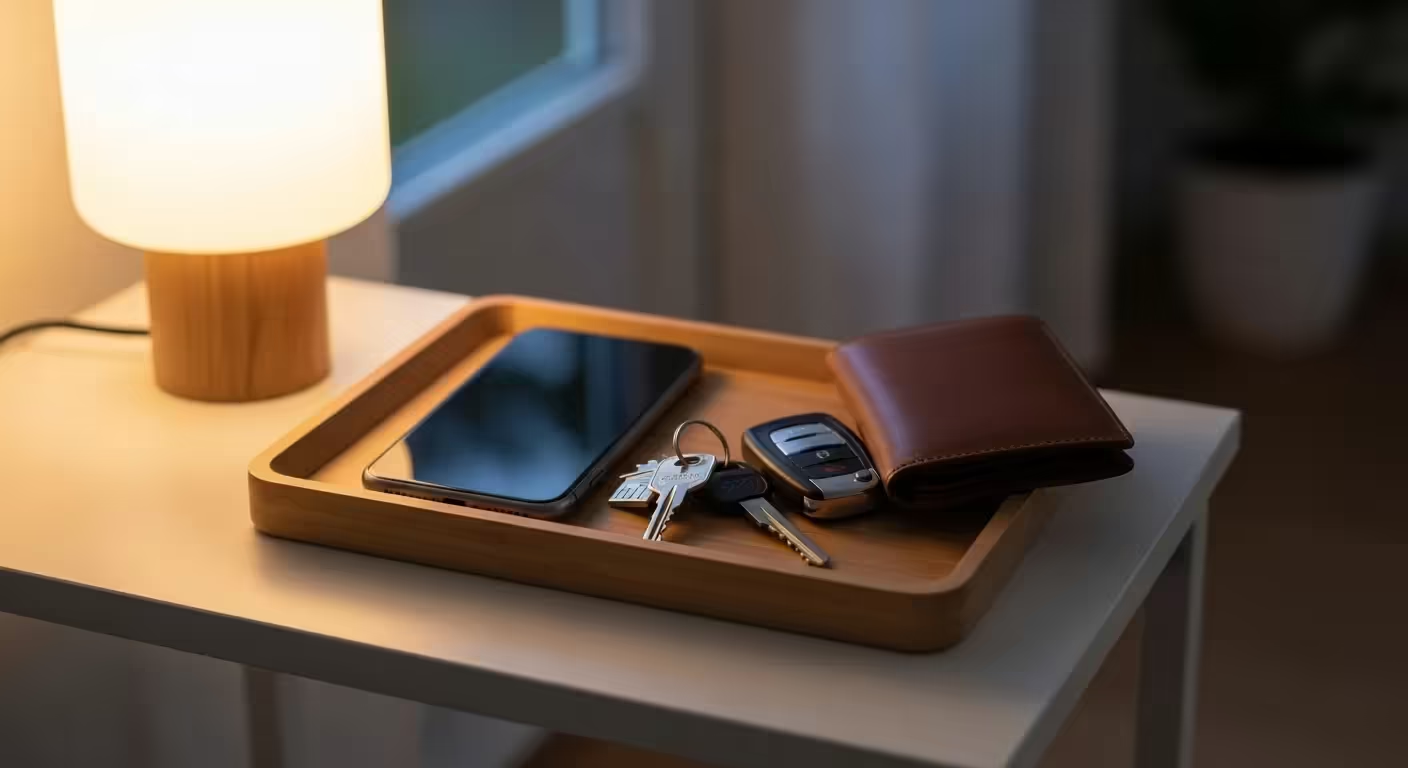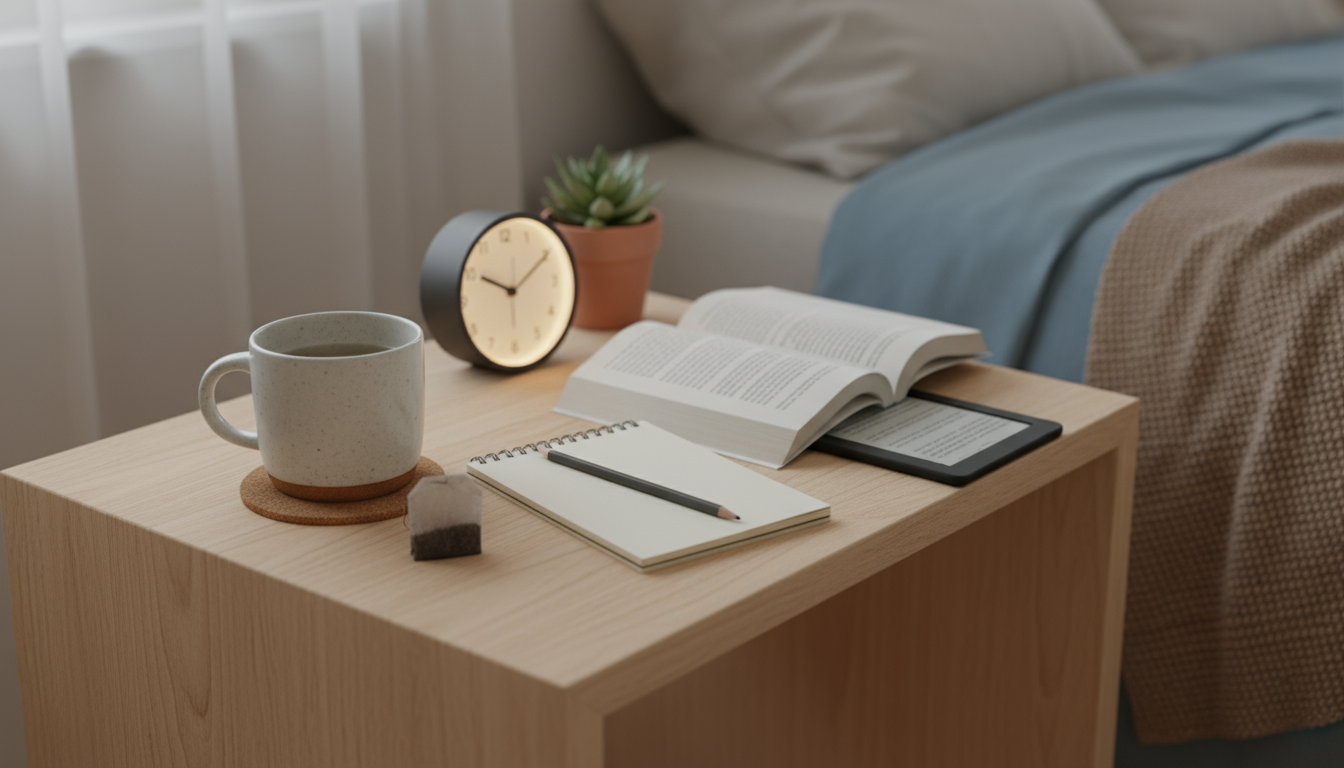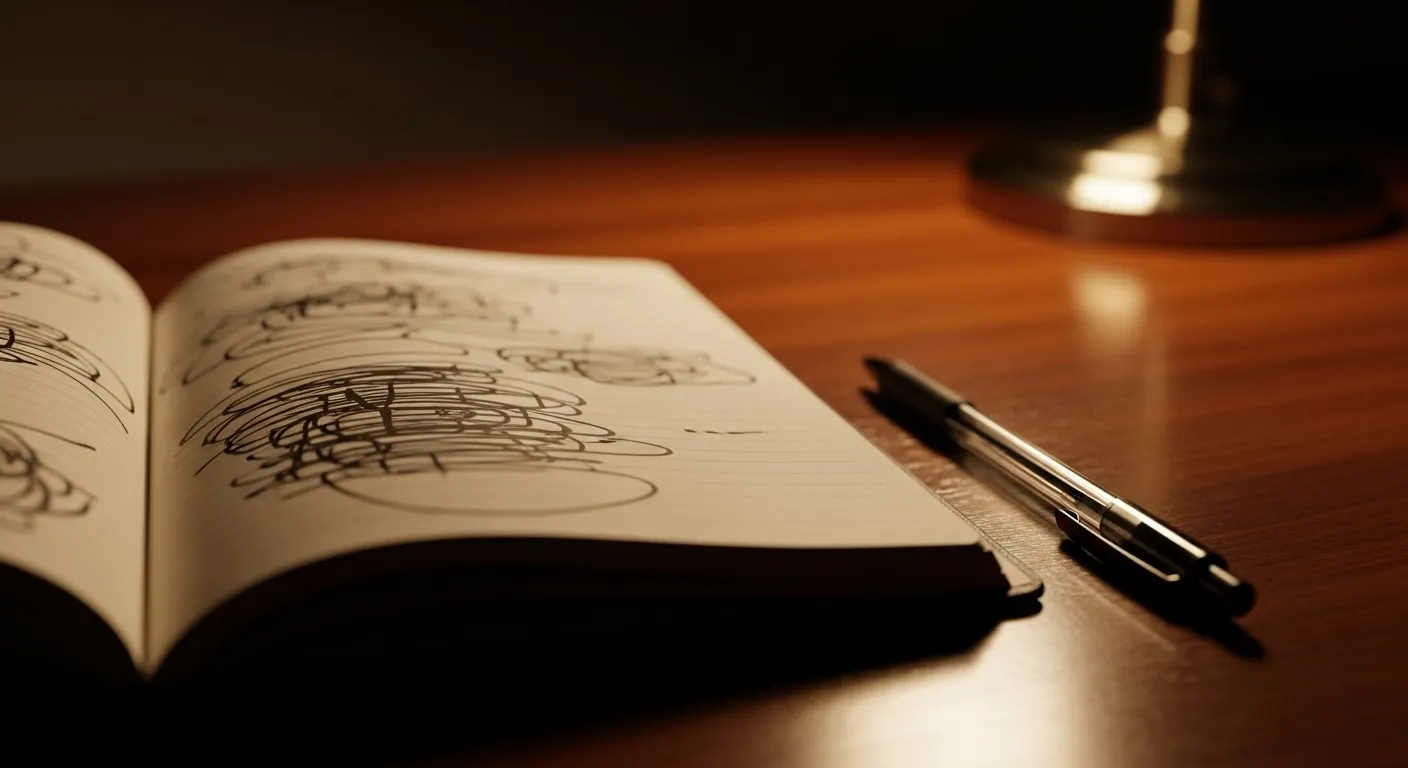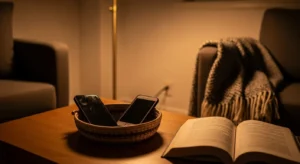
Do you ever end your day feeling wired but tired? Your mind buzzes with a dozen different thoughts. Your eyes ache from the screen’s glow. You know you need to rest, but your brain feels like it has too many tabs open. You reach for your phone one last time, just to check. An hour later, you’re still scrolling, feeling even more drained and a little frustrated with yourself.
This feeling is not a personal failure. It’s a modern friction, a direct result of living in a hyper-connected world that never truly switches off. Our brains weren’t designed for this constant stream of information, notifications, and demands. The line between work and rest has blurred into nonexistence, leaving us in a state of perpetual low-grade stress and fractured attention.
But what if you could reclaim your evenings? What if you could create a space of quiet clarity that allows your mind to truly recharge? What if you could end your day feeling calm and present, and wake up the next morning feeling refreshed and ready to focus? It is entirely possible. The solution is not about willpower or finding more hours in the day. It’s about building a simple, powerful ritual: a digital wind down routine.
Here at TheFocusedMethod.com, we believe that focus isn’t something you have; it’s something you practice. In this guide, we will walk you through the evidence and the practical steps to build an evening routine that protects your attention, reduces overwhelm, and sets you up for success. We will move beyond just “turning off your phone.” We will give you the tools to manage your energy, retrain your attention, and create a sustainable system for deep, meaningful focus. Let’s begin the journey to more peaceful evenings and more productive days.
📚 Table of Contents
- Understanding the Science of Your Attention
- The Four Essential Focus Rituals
- 1. The Startup Ritual: Winning the First Hour
- 2. The Deep Work Entry Ritual: Crossing the Threshold
- 3. Break Hygiene: The Art of the Restorative Pause
- 4. The Shutdown Ritual: Your Digital Wind-Down Routine
- Mental Tools for a Focused Mind
- Reframe Perfectionism: Embrace “Good Enough”
- Reduce Friction: Make Focus the Easy Choice
- Script Your Reset: A Plan for When You Falter
- Putting It Into Practice: Worked Examples
- Frequently Asked Questions About Focus and Unplugging
- 1. Can I listen to music or white noise during my digital wind down?
- 2. I’m a great multitasker. Is it really that bad for my focus?
- 3. What if I have no motivation to do my evening routine?
- 4. How does a tech-free evening actually help my focus the *next* day?
- Your Seven-Day Focus Challenge

Understanding the Science of Your Attention
Before we build the solution, we need to understand the problem. Why do our brains feel so scattered? It helps to think of your attention not as an infinite resource, but as a finite energy reserve, like a battery. Every single thing you do throughout the day either charges or drains this battery. Answering emails, scrolling social media, switching between tasks—these are all significant drains.
Our modern digital life is filled with activities that place a heavy burden on our cognitive resources. This is where a few key concepts come into play. Understanding them is the first step toward reclaiming your focus.

What is Cognitive Load?
Imagine you’re trying to carry a stack of books. One book is easy. Five is manageable. Twenty is a struggle. Your brain is similar. Cognitive load refers to the total amount of mental effort being used in your working memory. When you are constantly checking notifications, reading news alerts, and thinking about your to-do list all at once, you are placing an enormous cognitive load on your brain. It becomes overwhelmed, just like you would with too many books. This leads to decision fatigue, mental exhaustion, and an inability to think clearly. A proper digital wind down is designed specifically to reduce this load before you sleep, allowing your mind to process and file away the day’s events.

The High Cost of Context Switching
Have you ever been deep in a report and then quickly checked an email? It seems harmless, but that small action has a hidden cost. This is called context switching. It’s the act of shifting your attention from one unrelated task to another. Research, often discussed by sources like the American Psychological Association (https://www.apa.org), shows that even brief interruptions can derail your focus for up to 20 minutes. Each time you switch, your brain has to shut down the context for the old task and load up the context for the new one. Doing this all day long is like constantly starting and restarting a car engine. It burns an incredible amount of mental fuel and is a primary driver of that “wired but tired” feeling at night.

The Power of Monotasking and Flow
The opposite of context switching is monotasking, or single-tasking. It’s the simple, powerful act of focusing on one thing at a time. It dramatically lowers your cognitive load and is the gateway to a highly sought-after state of mind. You’ve likely experienced it before. It’s that magical state where you are so completely absorbed in an activity that time seems to fly by. The world around you fades away. This is called a flow state. In flow, you are not only incredibly productive, but you also feel energized and fulfilled by your work. The rituals we will discuss are designed to create the conditions for monotasking, making flow states more accessible during your day and deep rest more accessible at night.
By understanding these principles, you can see that a scattered mind isn’t a character flaw. It’s the predictable outcome of an environment that encourages high cognitive load and constant context switching. An evening routine that helps you unplug is your most powerful tool to counteract these forces, empty your mental cache, and allow your attention battery to fully recharge overnight.

The Four Essential Focus Rituals
Focus is a practice, and like any practice, it is built on consistent rituals. These four rituals work together as a complete system to manage your attention and energy throughout the entire day. While our primary goal is a successful digital wind down routine, its effectiveness is magnified when supported by other intentional practices. A good evening starts with a good morning.

1. The Startup Ritual: Winning the First Hour
How do you start your day? For many, it begins by grabbing the phone. You’re immediately flooded with notifications, news alerts, emails, and the curated lives of others. This reactive start immediately puts your brain on the defensive, skyrockets your cognitive load, and sets a distracted tone for the rest of the day. A Startup Ritual reclaims this critical first hour.
Instead of reaching for a screen, you begin with an analog activity. This could be five minutes of stretching, journaling one page of thoughts, meditating, or simply sitting with a cup of coffee and looking out the window. The goal is to give your brain a gentle, focused start, free from the demands of the outside world. This isn’t about adding more to your plate; it’s about creating a small pocket of quiet intention before the day’s chaos begins. It primes your mind for focus rather than reaction.

2. The Deep Work Entry Ritual: Crossing the Threshold
When it’s time to do important, focused work, how do you begin? Do you just open your laptop and hope for the best? This often leads to procrastination and distraction. A Deep Work Entry Ritual is a short, consistent sequence of actions that tells your brain, “It’s time to focus now.”
It can be incredibly simple. For example:
1. Clear your desk of everything except what you need for the task.
2. Pour a glass of water.
3. Turn your phone to silent and place it out of sight.
4. Set a timer for 45 minutes.
5. State your specific intention for the session out loud: “For the next 45 minutes, I will only work on the first draft of the project proposal.”
This sequence, when repeated consistently, becomes a powerful psychological trigger. It reduces the friction of starting and helps you transition more quickly into a state of monotasking and, eventually, flow.

3. Break Hygiene: The Art of the Restorative Pause
Not all breaks are created equal. When you feel your focus waning after a work block, what is your go-to? If it’s checking your phone, you aren’t actually taking a break. You are simply swapping one high-load cognitive task (your work) for another (processing a chaotic social media feed). This is poor break hygiene, and it drains your attention battery further instead of recharging it.
Good break hygiene involves stepping away from all screens. Stand up. Stretch. Look out a window at something far away to rest your eyes. Get a glass of water. Walk around for a few minutes. The key is to do something that is low-stimulation and preferably involves some light physical movement. A five-minute screen-free break is far more restorative than a 15-minute break spent scrolling. It allows your mind to briefly rest, which paradoxically strengthens your ability to focus when you return to your work.

4. The Shutdown Ritual: Your Digital Wind-Down Routine
This is the capstone ritual. It is the formal act of ending your workday and transitioning into a tech-free evening. Its purpose is twofold: to reassure your brain that all work-related loops can be closed for the day, and to create a firm boundary between your productive life and your personal life. Without this boundary, your brain stays in a state of semi-work, which is exhausting and prevents deep rest.
A complete shutdown has two parts. First, a work shutdown. Take five minutes to review your to-do list, migrate any unfinished tasks to tomorrow’s list, and plan your first action for the next day. This simple act tells your brain, “I have a plan. Nothing will be forgotten. You can let go.” Then, close your laptop. The second part is the personal shutdown: the digital wind down.
Your 20-Minute Digital Wind-Down Starter Pack:
This is a simple routine to begin with. The goal is consistency, not complexity. Set an alarm for 60-90 minutes before your intended bedtime. When it goes off, this routine begins.
Minutes 1-5: The Tech Tidy-Up. Go through your house and put your devices “to bed.” Plug in your phone in a room other than your bedroom. The kitchen or living room is ideal. Turn off your computer. Put away your tablet. This physical act of separation is incredibly powerful. It removes the temptation and sends a clear signal that screen time is over for the day.
Minutes 6-15: The Analog Activity. Replace screen time with a calming, non-digital activity. The key is to find something you genuinely enjoy. This isn’t a chore. Ideas include reading a physical book or magazine, listening to calm music or a podcast (without looking at the screen), tidying up a room, preparing your clothes for the next day, doing some light stretching, or journaling. You are replacing the high-stimulation glow of a screen with a low-stimulation, restorative activity.
Minutes 16-20: The Mindful Moment. Spend the last few minutes in quiet reflection or simple breathing. You don’t need a formal meditation practice. Simply sit comfortably, close your eyes, and focus on the sensation of your breath moving in and out. When your mind wanders (and it will), gently guide it back to your breath without judgment. This helps to lower your heart rate and calm your nervous system, preparing your body and mind for deep, restorative sleep.
This simple 20-minute sequence is the heart of a successful digital wind down routine. It reduces cognitive load, creates a clear boundary, and prepares you for rest. By practicing these four rituals, you create a structure for your day that protects and cultivates your most valuable resource: your focus.

Mental Tools for a Focused Mind
Building new routines is not just about actions; it’s also about mindset. Our brains often resist change, and we can be our own worst critics. Having a few mental tools, or “thought tools,” can help you navigate the internal friction that comes with building a more focused life. These reframes help you work with your brain instead of against it.

Reframe Perfectionism: Embrace “Good Enough”
One of the biggest obstacles to starting a new routine is perfectionism. We think we need the perfect setup, the perfect journal, the perfect hour of uninterrupted quiet. We tell ourselves, “I’ll start my digital wind down when things are less crazy.” But the “perfect” time never arrives. This all-or-nothing thinking often leads to doing nothing at all.
The reframe is to embrace the principle of “good enough.” A five-minute digital wind down is infinitely better than a zero-minute one. Reading one page of a book is better than scrolling for an hour. A messy, imperfect journal entry is better than an empty page. The goal is not perfection; it’s consistency. Small, imperfect actions, repeated over time, build powerful habits. Give yourself permission to be a beginner. Give yourself permission to be messy. Progress over perfection, always.

Reduce Friction: Make Focus the Easy Choice
Your brain is wired to follow the path of least resistance. If your phone is on your nightstand, checking it is easy. If a book is on your nightstand and your phone is charging in the kitchen, reading the book becomes the easier choice. This is the principle of reducing friction.
Instead of relying on willpower, which is a finite resource, intentionally design your environment to make your desired habits easier and your undesired habits harder.
– Want to read more in the evening? Leave a book on your pillow.
– Want to stop scrolling? Move your social media apps to the last page of your phone, inside a folder. Better yet, set a digital curfew using your phone’s wellness settings.
– Want to start your day without your phone? Buy a simple, cheap alarm clock so your phone doesn’t have to be the first thing you touch.
By making small, strategic changes to your environment, you nudge your behavior in the right direction. You make focusing and unplugging the path of least resistance, which is a far more reliable strategy than pure willpower.

Script Your Reset: A Plan for When You Falter
You will get distracted. You will have nights where you forget your routine and end up scrolling until midnight. This is not a failure. It is part of the process. The problem isn’t the slip-up; it’s the shame and guilt that often follow. We tell ourselves, “See, I can’t stick to anything,” and then we abandon the effort altogether.
To counteract this, you need a pre-planned script for when you get derailed. A compassionate, non-judgmental reset button. Your script could be as simple as saying to yourself:
“Okay, I got distracted. That’s human. It doesn’t erase my progress. My only job right now is to get back on track with the very next choice. I will put my phone down now and read for five minutes.”
This self-talk is crucial. It acknowledges the reality without judgment and provides a clear, simple, immediate next step. It short-circuits the shame spiral and turns a moment of distraction into an opportunity to practice the skill of returning to your intention. A successful focus practice isn’t about never getting distracted; it’s about getting better and faster at noticing the distraction and gently redirecting your attention.

Putting It Into Practice: Worked Examples
Theory is helpful, but seeing how these rituals apply in real-world scenarios makes them more tangible. Let’s explore how to use these tools in two common, challenging situations.

Scenario 1: The Tight Deadline
The Situation: You have a major project due in 48 hours. You feel immense pressure and the urge to work around the clock. Your instinct is to skip all routines, work late into the night, and keep your email open constantly, just in case.
The Unfocused Approach: You work frantically, fueled by caffeine and anxiety. You switch between writing the report, checking emails, and responding to messages. You work late, with your laptop in bed, and fall into an exhausted, restless sleep. The next day, you wake up feeling groggy and even more stressed. Your work is unfocused and prone to errors.
The Focused Method Approach:
1. Acknowledge the Pressure, then Double Down on Rituals. You recognize that under pressure, your focus rituals are more important, not less.
2. Use Deep Work Entry Rituals for Sprints. You break the project into 90-minute focused sprints. Before each sprint, you use your entry ritual: turn off all notifications, state your specific goal for that block (“Draft the introduction and first section”), and set a timer.
3. Practice Strict Break Hygiene. Between sprints, you take a mandatory 10-minute screen-free break. You walk away from your desk, stretch, and drink water. This isn’t wasted time; it’s strategic recovery that allows you to maintain high-quality focus in the next sprint.
4. Execute a Firm Shutdown Ritual. This is the most critical part. Even with the deadline, you commit to a non-negotiable shutdown time, perhaps an hour later than usual. You perform your shutdown ritual: plan the first task for tomorrow, close the laptop, and put it away. You then execute your digital wind down routine. This might feel counterintuitive, but the quality of sleep you get will make you far more effective the next day than an extra hour of exhausted, low-quality work. You’re trading one hour of poor work tonight for four hours of sharp, focused work tomorrow.

Scenario 2: The Noisy Home Environment
The Situation: You work from home, and your environment is filled with potential distractions: family members, pets, household chores, the doorbell. It feels impossible to find a quiet space for deep work, and by the evening, you feel frazzled and overstimulated.
The Unfocused Approach: You try to work through the noise, getting increasingly frustrated with every interruption. You wear headphones but still get distracted by visual movement. You feel guilty for not being present with your family and simultaneously resentful for not being able to focus on work. Your evening routine consists of zoning out in front of a screen to escape the day’s chaos.
The Focused Method Approach:
1. Control Your Controllables. You accept that you cannot eliminate all distractions, so you focus on what you can control. You invest in a good pair of noise-canceling headphones. You orient your desk to face a wall to minimize visual distractions.
2. Communicate Boundaries. You have a clear, kind conversation with your family. “Between 9 AM and 10:30 AM, when this door is closed and my headphones are on, I’m in a deep focus block. Please only interrupt me if it’s a true emergency. I’ll be fully present during my break at 10:30.” This manages expectations and creates a shared understanding.
3. Use Micro-Shutdowns. Throughout the day, when you transition from work time to family time (like a lunch break), you perform a “micro-shutdown.” You close the laptop and put your phone away. This allows you to be truly present for that 30-minute lunch break, which recharges you more effectively.
4. Prioritize the Evening Unplug. Because your day was filled with high sensory input, your digital wind down routine becomes your sanctuary. You make it a priority. You might choose a particularly calming analog activity, like listening to an audiobook or doing a simple puzzle. This dedicated time to unplug helps your nervous system settle after a stimulating day, leading to better sleep and a greater sense of peace.

Frequently Asked Questions About Focus and Unplugging
As you begin to implement these practices, questions will naturally arise. Here are answers to some of the most common ones we hear from our community at TheFocusedMethod.com.
1. Can I listen to music or white noise during my digital wind down?
Absolutely. The goal of the digital wind down is not complete sensory deprivation, but a reduction in high-stimulation, information-heavy input. For many people, music, ambient sounds, or white noise can be incredibly helpful for calming the mind and masking distracting household sounds. The key is to choose audio that doesn’t demand your active attention. Lyrical music can sometimes be distracting, as your brain tries to process the words. Consider instrumental music, classical, lo-fi beats, or nature sounds. The most important rule is to “set it and forget it.” Start your playlist or sound machine and then put the device away. The temptation to browse and pick the “perfect” song is a trap that can pull you right back into screen time.
2. I’m a great multitasker. Is it really that bad for my focus?
This is a very common belief, but the evidence from neuroscience is quite clear. As researchers supported by institutions like the National Institutes of Health (https://www.nih.gov) have shown, the human brain does not truly multitask. Instead, it performs rapid-fire context switching. What feels like doing two things at once is actually your brain frantically jumping back and forth between tasks. As we discussed earlier, this process is incredibly inefficient. It burns through mental energy, increases the likelihood of errors, and raises your stress levels. Monotasking may feel slower at first, but it produces a higher quality of work in less time and with less mental strain. Giving up the myth of multitasking is a foundational step toward deeper focus and a calmer mind.
3. What if I have no motivation to do my evening routine?
Motivation is a fickle emotion; it comes and goes. Relying on it to build habits is an unreliable strategy. The most effective approach is to rely on systems and to lower the barrier to entry so drastically that motivation becomes irrelevant. On days when you feel zero motivation, lean on your “good enough” principle. Tell yourself you don’t have to do the full 20-minute routine. Your only job is to do a two-minute version. Tidy up one thing and put your phone on the charger in the other room. That’s it. That’s the win for tonight. More often than not, starting the tiny two-minute version will give you the momentum to do a little more. But even if it doesn’t, you have maintained the chain of consistency, which is far more important than the duration of the routine on any single night.
4. How does a tech-free evening actually help my focus the *next* day?
The connection is direct and powerful. The quality of your sleep is one of the single biggest predictors of your focus, mood, and cognitive performance the following day. The blue light emitted by screens is known to suppress the production of melatonin, the hormone that signals to your body that it’s time to sleep. Scrolling through stimulating content also keeps your mind in an alert, information-processing state. A tech-free evening allows your brain’s natural sleep processes to unfold without interference. This leads to falling asleep faster, achieving more deep and REM sleep, and waking up more rested. A well-rested brain has a much fuller “attention battery.” It is better at managing cognitive load, resisting distractions, and entering flow states. Your evening routine is not just about ending the current day well; it’s the single best preparation you can do for a focused and productive tomorrow.
Disclaimer: The information provided in this article is for informational purposes only and is not intended to be a substitute for professional medical advice, diagnosis, or treatment. Always seek the advice of your physician or other qualified health provider with any questions you may have regarding a medical condition or mental health.

Your Seven-Day Focus Challenge
Reading about focus is one thing; practicing it is another. The best way to see the impact of these ideas is to experience them for yourself. We invite you to take a simple, seven-day challenge. Don’t try to change everything at once. Just commit to these three small actions every day for the next week.
1. Wait 15 Minutes. For the first 15 minutes after you wake up, do not look at a screen. Not your phone, not your computer, not the TV. Let your brain wake up gently. Notice how this changes the tone of your morning.
2. Take One True Break. Sometime during your workday, take one 5-to-10-minute break where you step away from all screens. Walk, stretch, look out the window. Just one. Observe how you feel when you return to your work.
3. Do a 10-Minute Wind-Down. This is the cornerstone. For just 10 minutes before bed, put your phone away—ideally in another room—and read a physical book, listen to some music, or just tidy up. That’s it. Ten minutes of screen-free quiet to end your day.
That is your entire commitment. It is small, achievable, and powerful. At the end of the seven days, check in with yourself. How is your sleep? How is your ability to focus during the day? How is your overall sense of calm versus overwhelm? We suspect you’ll feel a meaningful difference. True, sustainable focus is not built through grand, sweeping changes, but through small, consistent rituals that compound over time. You have the power to reclaim your attention. Start today.






